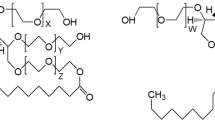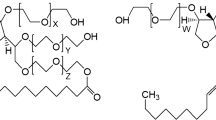Abstract
Purpose
To provide new insights into how protein-surfactant competitive adsorbtion and corresponding surface tension reduction properties at the air-water and oil-water interface are impacted by the type of protein and the associated protein surface rheology.
Method
Interfacial Rheology was utilized to obtain surface G’ and G” as a function of frequency. Force tensiometry was utilized to obtain changes in surface tension as a function of surfactant concentration. The impact on surface properties of two different proteins i.e. BSA and Lysozyme was investigated as a function of surfactant concentration i.e. polysorbates PS 20, PS 80 and Poloxomer (Kolliphor P188).
Results
Surface tension and interfacial tension measurements for BSA showed that in mixed BSA/polysorbate surfactant systems, BSA dominates the interfacial behavior at both the air-water and oil-water interfaces, until a high polysorbate concentration of 0.1 mg/ml. At these high polysorbate concentrations a mixed BSA-Polysorbate interfacial layer is formed as corroborated by the surface elasticity values being lower than that of pure BSA but higher than that of pure Polysorbate. For Kolliphor, it was observed that Kolliphor was unable to displace BSA at any concentration. This is corroborated by the high surface elasticity of the BSA which is maintained in the presence of Kolliphor. Surface and interfacial tension measurements for lysozyme show that for mixed lysozyme/polysorbate surfactant systems, the surface tension values are lower than that exhibited by either the lysozyme or the polysorbate surfactants. This potentially indicates the formation of a mixed layer of lysozyme and polysorbate. At the high polysorbate concentrations probed, the surface elasticity values are however closer to that of pure polysorbates, indicating that the mixed layer may be more heavily polysorbate dominated, especially at high polysorbate concentrations. For Kolliphor, the response was similar to that seen in the Kolliphor-BSA system in which the Kolliphor was not able to displace the protein i.e. Lysozyme.
Conclusions
In conclusion, it was seen that competitive adsorption between proteins and common excipient surfactants is dictated by the type of protein and its effective structuring/rigidity at the surface as reflected through surface elasticity and surface tan delta values. BSA was seen to exhibit a higher surface elasticity than lysozyme, and therefore has a more rigid structure and is more competitive at the interface.







Similar content being viewed by others
References
Meng G, Chan JCK, Rousseau D, Li-Chan ECY. Study of protein−lipid interactions at the bovine serum albumin/oil Interface by Raman microspectroscopy. J Agric Food Chem. 2005;53:845–52.
Adler M. Challenges in the development of pre-filled syringes for biologics from a formulation scientist’s point of view. 2012. Retrieved November 12, 2018, from https://www.americanpharmaceuticalreview.com/Featured-Articles/38372-Challenges-in-the-Development-of-Pre-filled-Syringes-for-Biologics-from-a-Formulation-Scientist-s-Point-of-View/.
Siew A. The truth behind protein aggregation in prefilled syringes. BioPharm International. 2016;29:50–2.
Amin S, Barnett G, Pathak J, Roberts C, Sarangapani P. Protein aggregation, particle formation, characterization & rheology. Curr Opin Colloid Interface Sci. 2014;19:438–49.
Roberts CJ. Therapeutic protein aggregation: mechanisms, design, and control. Trends Biotechnol. 2014;32(7):372–80.
Chi EY, Krishnan S, Randolph TW, Carpenter JF. Physical stability of proteins in aqueous solution: mechanism and driving forces in nonnative protein aggregation. Pharm Res. 2003;20:1325–36.
Zhang Z, Orski S, Woys AM, Yuan G, Zarraga IE, Wagner NJ, et al. Adsorption of polysorbate 20 and proteins on hydrophobic polystyrene surfaces studied by neutron reflectrometry. Colloids Surf B: Biointerfaces. 2018;168:94–102. https://doi.org/10.1016/j.colsurfb.2018.04.036.
Gerhardt A, Mcumber AC, Nguyen BH, Lewus R, Schwartz DK, Carpenter JF, et al. Surfactant effects on particle generation in antibody formulations in pre-filled syringes. J Pharm Sci. 2015;104:4056–64.
Lee HJ, McAuley A, Schilke KF, McGuire J. Molecular origins of surfactant-mediated stabilization of protein drugs. Adv Drug Deliv Rev. 2011;63:1160–71.
Kapp SJ, Larsson I, De Weert MV, Cárdenas M, Jorgensen L. Competitive adsorption of monoclonal antibodies and nonionic surfactants at solid hydrophobic surfaces. J Pharm Sci. 2015;104:593–601.
Pinholt C, Hartvig RA, Medlicott NJ, Jorgensen L. The importance of interfaces in protein drug delivery –why is protein adsorption of interest in pharmaceutical formulations? Expert Opin Drug Deliv. 2011;8:949–64.
Kahn T, Mahler H, Kishore R. Key interactions of surfactants in therapeutic protein formulations: a review. Eur J Pharm Biopharm. 2015;97:60–7.
Dixit N, Maloney K, Kalonia D. Protein-silicone oil interactions: comparative effect of nonionic surfactants on the interfacial behavior of a fusion protein. Pharm Res. 2013;30:1848–59.
Kim HL, Mcauley A, Mcguire J. Protein effects on surfactant adsorption suggest the dominant mode of surfactant-mediated stabilization of protein. J Pharm Sci. 2014;103:1337–45.
Mcauley WJ, Jones DS, Kett VL. Characterisation of the interaction of lactate dehydrogenase with Tween-20 using isothermal titration calorimetry, interfacial Rheometry and surface tension measurements. J Pharm Sci. 2009;98(8):2659–69.
Ayorinde F, Gelain SV, Johnson J, Wan LW. Analysis of some commercial polysorbate formulations using matrix-assisted laser desorption/ionization time-of-flight mass spectrometry. Rapid Commun Mass Spectrom. 2000;14:2116–24.
Prosser AJ, Franses EI. Adsorption and surface tension of ionic surfactants at the air-water interface: review and evaluation of equilibrium models. Colloids and Surfaces A. 2001;178:1–40.
Kishore RSK, Kiese S, Fischer S, Pappenberger A, Grauschopf U, Mahler H. The degradation of Polysorbates 20 and 80 and its potential impact on the stability of biotherapeutics. Pharm Res. 2011;28:1194–210.
Kopac T, Bozgeyik K, Yener J. Effect of pH and temperature on the adsorption of bovine serum albumin onto titanium dioxide. Colloids Surf A Physicochem Eng Asp. 2008;322(1–3):19–28.
Kudelski A. Influence of electrostatically bound proteins on the structure of linkage monolayers: adsorption of bovine serum albumin on silver and gold substrates coated with monolayers of 2-mercaptoethanesulphonate. Vib Spectrosc. 2003;33(1–2):197–204.
Nuhu M. Protein- protein interactions and aggregation in biotherapeutics:a thesis submitted to the University of Manchester for the degree of doctor of philosophy in the Faculty of Engineering and Physical Sciences: University of Manchester; 2015. p. 1–236.
Albumins from other species - Albumin | Sigma-Aldrich. (n.d.). Retrieved November 14, 2018, from https://www.sigmaaldrich.com/life-science/biochemicals/biochemical-products.html?TablePage=103994915
Estey T, Kang J, Schwendeman S, Carpenter J. BSA degradation under acidic conditions: a model for protein instability during Release from PLGA delivery systems. J Pharm Sci. 2006;95(7):1626–39.
Swaminathan R, Ravi VK, Kumar S, Kumar MV, Chandra N. Lysozyme: a model protein for amyloid research. Adv Protein Chem Struct Biol. 2011;84:63–111.
Gourbatsi E, Povey J, Uddin S, Smales MC. Biotherapeutic protein formulation variables influence protein integrity and can promote post-translational modifications as shown using chicken egg white lysozyme as a model system. Biotechnol Lett. 2016;38:589–96.
McClellan SJ, Franses EI. Effect of concentration and denaturation on adsorption and surface tension of bovine serum albumin. Colloids Surf B: Biointerfaces. 2003;28:63–75.
Nino MRR, Patino JMR. Surface tension of bovine serum albumin and tween 20 at the air water interface. J Am Oil Chem Soc. 1998;75:1241–8.
Zadymova N, Yampol’skaya G, Filatova LY. Interaction of bovine serum albumin with nonionic surfactant tween 80 in aqueous solutions: complexation and association. Colloid Journal. 2005;68:187–97.
Burgess DJ, Sahin NO. Interfacial rheological and tension properties of protein films. J Colloid Interface Sci. 1997;189:74–82.
Jiang Y, Nashed-Samuel Y, Li C, Liu W, Pollastrini J, Mallard D, et al. Tungsten-induced protein aggregation: solution behavior. J Pharm Sci. 2009;98:4695–710.
Jones LS, Kaufmann A, Middaugh CR. Silicone oil induced aggregation of proteins. J Pharm Sci. 2005;94:918–27.
Markovic I. Challenges associated with extractable and/or leachable substances in therapeutic biologic protein products. Am Pharm Rev. 2006;9:20–7.
Posocco P, Perazzo A, Preziosi V, Laurini E, Prict S, Guido S. Interfacial tension of oil/water emulsions with mixed non-ionic surfactants: comparison between experiements and molecular simulations. RSC Adv. 2016;6:4723–9.
Du Noüy PL. A new apparatus for measuring surface tension. J Gen Physiol. 1919;1:521–4.
Huh C, Mason SG. A rigorous theory of ring tensiometry. Colloid Polymer Sci. 1957;253:566–80.
Zuidema HH, Waters GW. Ring method for the determination of interfacial tension. Ind Eng Chem. 1941;13:312–3.
Discovery hybrid rheometer: getting started guide | TA instruments. Retrieved November 15, 2018, from http://pages.mtu.edu/~fmorriso/cm4655/TAInstruments/2013TA_DHRGettingStartedGuide.pdf.
Mitropolous V, Mutze A. Fischer P. properties of protein adsorption layers at the air/water and oil/water interface: a comparison in light of the thermodynamical stability of proteins. Adv Colloid Interf Sci. 2014;206:195–206.
Product information: Tween 20 | Sigma-Aldrich. Retrieved November 14, 2018, from https://www.sigmaaldrich.com/content/dam/sigma-aldrich/docs/Sigma/Product_Information_Sheet/1/p5927pis.pdf.
Product information: Tween 80 | Sigma-Aldrich. Retrieved November 14, 2018, https://www.sigmaaldrich.com/content/dam/sigma-aldrich/docs/Sigma-Aldrich/Product_Information_Sheet/p8074pis.pdf.
Narvaez AR, Vaidya SV. Protein-surfactant interactions at the air- water Interface. Excipient applications in formulation design and drug delivery. Switzerland: Springer International Publishing; 2015.
Mackie AR, Gunning AP, Ridout MJ, Wilde PJ, Rodriguez Patino J. In situ measurement of the displacement of protein films from the air/water interface by surfactant. Biomacromolecules. 2001;2(3):1001–6.
Acknowledgments and Disclosures
We would like to acknowledge Croda Inc., for providing us with samples of Polysorbate 20 and Polysorbate 80.
Author information
Authors and Affiliations
Corresponding author
Additional information
Publisher’s Note
Springer Nature remains neutral with regard to jurisdictional claims in published maps and institutional affiliations.
Rights and permissions
About this article
Cite this article
Begum, F., Amin, S. Investigating the Influence of Polysorbate 20/80 and Polaxomer P188 on the Surface & Interfacial Properties of Bovine Serum Albumin and Lysozyme. Pharm Res 36, 107 (2019). https://doi.org/10.1007/s11095-019-2631-6
Received:
Accepted:
Published:
DOI: https://doi.org/10.1007/s11095-019-2631-6




